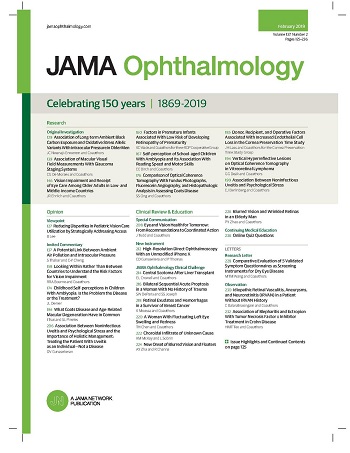与黄斑病变相关的全身药物
IF 9.2
1区 医学
Q1 OPHTHALMOLOGY
引用次数: 0
摘要
重要性:全身性药物可能有未被识别的黄斑毒性作用;早期识别可能对视力保护很重要。目的通过药物警戒报告识别与黄斑病变潜在相关的全身性药物,并在全国遭遇数据库中评估其黄斑不良反应。该研究分为两部分,包括(1)使用2014年7月至2023年12月期间来自美国食品和药物管理局不良事件报告系统(FAERS)的15748例黄斑病变相关的个例安全报告,对候选药物进行不成比例分析,以及(2)使用韩国健康保险审查和评估服务(HIRA)数据库对候选药物使用者进行关联评估的基于人群的队列研究。覆盖约5000万人。数据分析时间为2015年1月1日至2023年12月31日。暴露在FAERS中被确定为候选信号的全身性药物的使用。报告FAERS中信号检测的优势比和HIRA中黄斑病变的发病率比、风险比和累积发病率。结果在FAERS的前30个黄斑病变信号中,发现了5种未被充分认识到的黄斑毒性作用的全身药物——芬戈莫德、阿哌沙班、紫杉醇、依鲁替尼和西地那非。在HIRA中,暴露后黄斑病变的发生率比(与暴露前相比),芬戈莫德为1.92 (95% CI, 0.62-5.96),阿哌沙班为3.08 (95% CI, 2.68-3.54),紫杉醇为2.85 (95% CI, 1.62-5.02),伊鲁替尼为3.71 (95% CI, 2.58-5.34),西地那非为2.75 (95% CI, 2.17-3.48)。累积发病率从4.4% (fingolimod)到15.7% (apixaban)不等。紫杉醇(第三和第一个四分位数的风险比为2.01 [95% CI, 1.77-2.29])和依鲁替尼(第四和第一个四分位数的风险比为4.82 [95% CI, 1.39-16.81])的剂量-反应关系。这些发现表明,药物警戒信号检测和全国健康声明分析的整合确定了黄斑病变与阿哌沙班、紫杉醇、依鲁替尼和西地那非的关联。这种联合方法提供了一种潜在的经济有效的、可靠的方法来识别可能被低估的黄斑不良反应的全身药物。本文章由计算机程序翻译,如有差异,请以英文原文为准。
Systemic Drugs Associated With Maculopathy
Importance Systemic medications may have unrecognized macular toxic effects; early identification might be important for vision preservation. Objectives To identify systemic drugs potentially associated with maculopathy via pharmacovigilance reporting and to evaluate their macular adverse effects in a nationwide encounter database. Design, Setting, and Participants This 2-part study included (1) disproportionality analysis for candidate identification, using 15 748 maculopathy-related individual case safety reports from the US Food and Drug Administration Adverse Event Reporting System (FAERS) between July 2014 and December 2023, and (2) a population-based cohort study for association evaluation, using the South Korean Health Insurance Review and Assessment Service (HIRA) database among users of the candidate drugs, covering approximately 50 million individuals. Data were analyzed from January 1, 2015, to December 31, 2023. Exposure Use of systemic drugs identified as candidate signals in FAERS. Main Outcomes and Measures Reporting odds ratios for signal detection in FAERS and incidence rate ratios, hazard ratios, and cumulative incidence of maculopathy in HIRA. Results Five systemic drugs with underrecognized macular toxic effects—fingolimod, apixaban, paclitaxel, ibrutinib, and sildenafil—were identified among the top 30 maculopathy signals in FAERS. In HIRA, the incidence rate ratios for maculopathy following exposure (vs preexposure) were 1.92 (95% CI, 0.62-5.96) for fingolimod, 3.08 (95% CI, 2.68-3.54) for apixaban, 2.85 (95% CI, 1.62-5.02) for paclitaxel, 3.71 (95% CI, 2.58-5.34) for ibrutinib, and 2.75 (95% CI, 2.17-3.48) for sildenafil. The cumulative incidence rates ranged from 4.4% (fingolimod) to 15.7% (apixaban). Dose-response relationships were observed for paclitaxel (hazard ratio, 2.01 [95% CI, 1.77-2.29] for third vs first quartile) and ibrutinib (hazard ratio, 4.82 [95% CI, 1.39-16.81] for fourth vs first quartile). Conclusions and Relevance These findings suggest that the integration of pharmacovigilance signal detection and nationwide health claims analysis identified associations of maculopathy with apixaban, paclitaxel, ibrutinib, and sildenafil. This combined approach offers a potentially cost-effective, robust method for identifying systemic drugs with possibly underrecognized macular adverse effects.
求助全文
通过发布文献求助,成功后即可免费获取论文全文。
去求助
来源期刊

JAMA ophthalmology
OPHTHALMOLOGY-
CiteScore
13.20
自引率
3.70%
发文量
340
期刊介绍:
JAMA Ophthalmology, with a rich history of continuous publication since 1869, stands as a distinguished international, peer-reviewed journal dedicated to ophthalmology and visual science. In 2019, the journal proudly commemorated 150 years of uninterrupted service to the field. As a member of the esteemed JAMA Network, a consortium renowned for its peer-reviewed general medical and specialty publications, JAMA Ophthalmology upholds the highest standards of excellence in disseminating cutting-edge research and insights. Join us in celebrating our legacy and advancing the frontiers of ophthalmology and visual science.
 求助内容:
求助内容: 应助结果提醒方式:
应助结果提醒方式:


